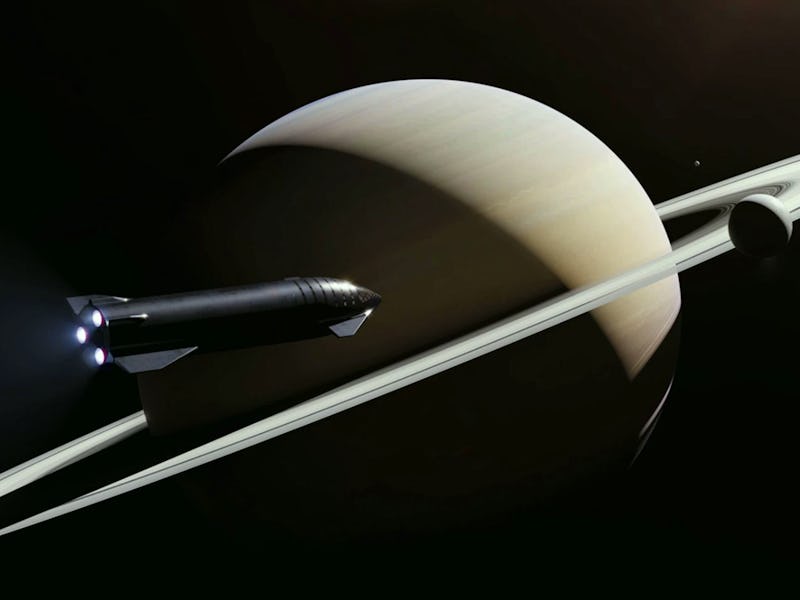SpaceX details new timeline for sending humans to the moon, Mars and beyond
The Starship is about to embark on major voyages.

SpaceX wants to get to the moon, and it wants to get there fast. On Friday, company president Gwynne Shotwell stated that SpaceX’s goal is to send humans and cargo to the moon by 2022.
Shotwell made the comments during an on-stage appearance at New York’s Metropolitan Opera, speaking with investor Ron Baron. Shotwell, in remarks shared by CNBC reporter Michael Sheetz via Twitter, also reiterated the company’s goal to fly the under-development Starship rocket to orbit by next year.
It’s the latest in a series of bold proclamations from SpaceX officials, which are painting a picture of far-flung space exploration over the coming decades. Plans include landing humans on the moon, building propellant depots to refuel the Starship, and building moon bases and cities on Mars at the same time.
Where does it end? Shotwell stated during her Friday appearance that humanity could start making its way to another potentially habitable solar system within her lifetime: “I think we will have a propulsion breakthrough in my lifetime that we can then say we will build a ship and start the journey.”
The Starship landing on Mars.
SpaceX: how the next few years are starting to develop
Shotwell’s comments come just days after an appearance at the International Astronautical Congress on October 22 in Washington, D.C. During her on-stage interview, she described a speedy timetable for the next few years
“Aspirationally, we want to get Starship to orbit within a year. We definitely want to land it on the moon before 2022, we want to basically stage cargo there to make sure that there’s resources for the folks that ultimately land on the moon by 2024 if things go well. So that’s an aspirational timeframe. [Yusaku Maezawa booked] a trip around the moon in the 2023 timeframe, in Starship.”
Her full appearance is available below:
SpaceX is currently developing the Starship at facilities in both Texas and Florida. Following a successful 150-meter jump with a miniaturized “Starhopper” vessel in August, CEO Elon Musk unveiled a full-size Mk.1 prototype on September 28. The first step is to fly a prototype 20 kilometers into the air, before aiming for an orbital flight.
Starship size comparison.
The Starship’s Raptor engine is fueled by liquid oxygen and methane. Unlike the Falcon 9’s Merlin engine, which uses rocket propellant, the Raptor could refuel by harvesting resources from Mars and other places by setting up a propellant depot.
Musk outlined a plan in September 2017 to send six rockets to Mars with enough resources to set up a depot and fuel the return flight. Although he suggested that the first two unmanned rockets could fly by 2022, in February 2019 he stated the moon mission would take priority. Shotwell’s comments suggest that the moon mission is still scheduled for 2023, which places the first Mars voyage sometime after.
From there, the goal is to expand out the Mars base to eventually reach a city-sized settlement by 2050. That would be a big enough goal for any firm, but SpaceX principal Mars development engineer Paul Wooster explained this month that the Starship enables the firm to both build a city on Mars and establish a base on the moon at the same time.
“Because it’s the same system that’s being used for going to the moon and going to Mars, it’s not something where you have to stop going to the moon in order to go to Mars,” Wooster explained on Saturday at the 22nd annual Mars Society Convention at the University of Southern California. “We’re really excited about the possibilities of doing both, having bases on the moon while we’re also setting up these cities on Mars.”
SpaceX's Starship landing on the moon.
It might be tough to set up a base on the moon. Musk noted earlier this month that unlike Mars, which has an atmosphere of carbon dioxide, the moon doesn’t have readily-available carbon floating around an atmosphere. Musk suggested that humans could find resources in craters.
Where will SpaceX go after that? Musk said in September 2018 that, thanks to its refuel-and-takeoff design, the Starship could enable trips to “Mars, Moon, maybe Venus, the moons of Jupiter, throughout the Solar System.”
Based on Shotwell’s comments Friday, the Solar System could be just the beginning.